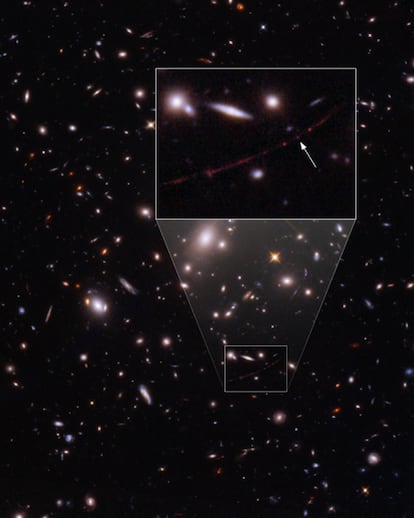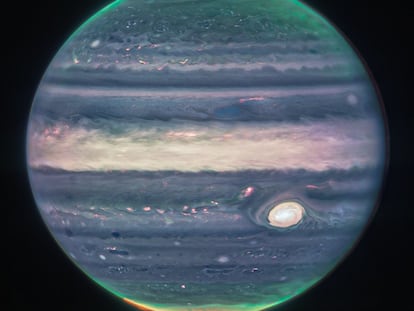James Webb Telescope rediscovers Earendel, the farthest known star in the universe
The space probe has taken an even more detailed image of the orb, which is 28 billion light-years from Earth

Although the new James Webb Space Telescope has made headlines with its recent images of deep space, its predecessor, the venerable Hubble Space Telescope, launched in 1990, is still operational and prompting new discoveries, for example, the March observation of Earendel, the farthest known star in the universe.
Few stars have their own names. In this case, the name Earendel derives from Old English words meaning “morning star” or “rising light.” Fans of J.R.R. Tolkien will remember that one of the characters in The Silmarillion goes by a very similar name – Eärendil –, but this is pure coincidence.
The surprising thing about Earendel is its remoteness. The light that the Hubble telescope captured was emitted when the universe was less than a billion years old. In other words, the light had been traveling through space for almost 13 billion years before it was picked up by the Hubble.
Earendel can only be seen under very specific circumstances, which was why it was one of the main targets of the James Webb, which was launched on December 25, 2021. Fortunately, given the time of year, the telescope can see the southern Cetus constellation which contains Earendel. With its powerful resolution and infrared cameras, James Webb took a new, even more detailed image of the star and the arc of light surrounding it on July 30. This arc of light, which makes the star appear brighter, has also been given a name: the Sunrise Arc.
Cosmic magnifying glass
In December, the James Webb will once again point its mirrors at Earendel in order to carry out a spectral analysis to confirm or rule out the presence of heavy elements. So far, based solely on the Hubble and James Webb images, more than 4,700 scientific articles have been published about the star. It is the furthest individual object that we can currently distinguish in the cosmos – although there are already reports of three or four more, very old stars that can be identified thanks to gravitational lensing.

With stars that are so remote, astronomers don’t talk about distance but rather “redshift,” a measure of how much their light has been “dilated” as a result of the expansion of the universe. In the case of Earendel, that index is 6.2, meaning it is 28 billion light-years from Earth. The star that held the previous record – nicknamed Icarus, in the constellation of Leo – is not half that figure.
It seems like a paradox: how is it possible to see an object at that distance when the universe has only existed for around 13.8 billion years? The star’s light should not have had time to reach us yet.
The answer to this paradox is that space is not static, but rather expanding at an accelerating rate. When Earendel’s light began its journey, the universe was very young and therefore much smaller than it is now. Since then, space has been expanding and the distance between galaxies has become greater and greater.
What’s also surprising about Earendel is that it is an isolated star, not a galaxy. The oldest galaxies do not appear in the Hubble photos as the pretty spirals we know, but as irregular masses of reddish-hued gas in which no structure can be distinguished. In reality, this color is the result of how the images have been rendered.

Earendel is a huge star – or rather, it was, because it has been losing mass for eons. It may be a legendary Population III star, which were the first to appear after the Big Bang. These stars only contain primordial hydrogen and helium as atoms of other metals did not exist yet. These heavier atoms would form as a result of the nuclear reactions that occur during the evolution of these stars.
It is estimated that Earendel’s mass is between 50 and a hundred times greater than the Sun, and that it hsa a surface temperature of 20,000°C (36,000°F). That would make it extremely bright, with a bluish-white glow. But no matter how bright it is, an isolated star should be invisible from such a distance.
That we can see it is due to an unusual circumstance. Between the star and Earth there is a small group of galaxies whose gravity acts like a lens that both concentrates and distorts the light from more distant objects.
What’s more, Earendel is located precisely in a narrow area of that giant magnifying glass where the effect of the gravitational lens is greatest. Thanks to this effect, the star’s light can be magnified between 1,000 and 40,000 times – enough for it to be detected by the Hubble. That is, after the telescope has spent nine hours looking at the same region of the sky. Photon by photon, the telescope has captured the light from Earendel on its long journey across the universe.
Tu suscripción se está usando en otro dispositivo
¿Quieres añadir otro usuario a tu suscripción?
Si continúas leyendo en este dispositivo, no se podrá leer en el otro.
FlechaTu suscripción se está usando en otro dispositivo y solo puedes acceder a EL PAÍS desde un dispositivo a la vez.
Si quieres compartir tu cuenta, cambia tu suscripción a la modalidad Premium, así podrás añadir otro usuario. Cada uno accederá con su propia cuenta de email, lo que os permitirá personalizar vuestra experiencia en EL PAÍS.
¿Tienes una suscripción de empresa? Accede aquí para contratar más cuentas.
En el caso de no saber quién está usando tu cuenta, te recomendamos cambiar tu contraseña aquí.
Si decides continuar compartiendo tu cuenta, este mensaje se mostrará en tu dispositivo y en el de la otra persona que está usando tu cuenta de forma indefinida, afectando a tu experiencia de lectura. Puedes consultar aquí los términos y condiciones de la suscripción digital.
More information
Últimas noticias
Most viewed
- Reinhard Genzel, Nobel laureate in physics: ‘One-minute videos will never give you the truth’
- Oona Chaplin: ‘I told James Cameron that I was living in a treehouse and starting a permaculture project with a friend’
- Pablo Escobar’s hippos: A serious environmental problem, 40 years on
- Why we lost the habit of sleeping in two segments and how that changed our sense of time
- Charles Dubouloz, mountaineering star, retires at 36 with a farewell tour inspired by Walter Bonatti











































